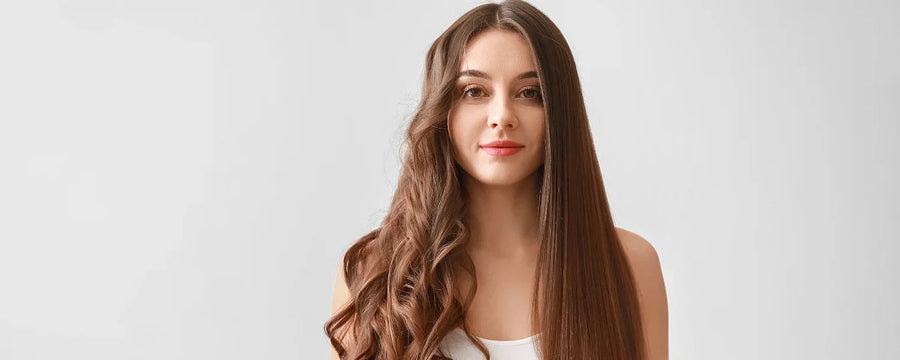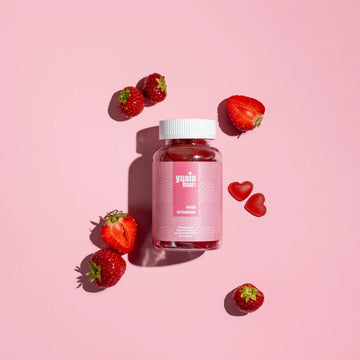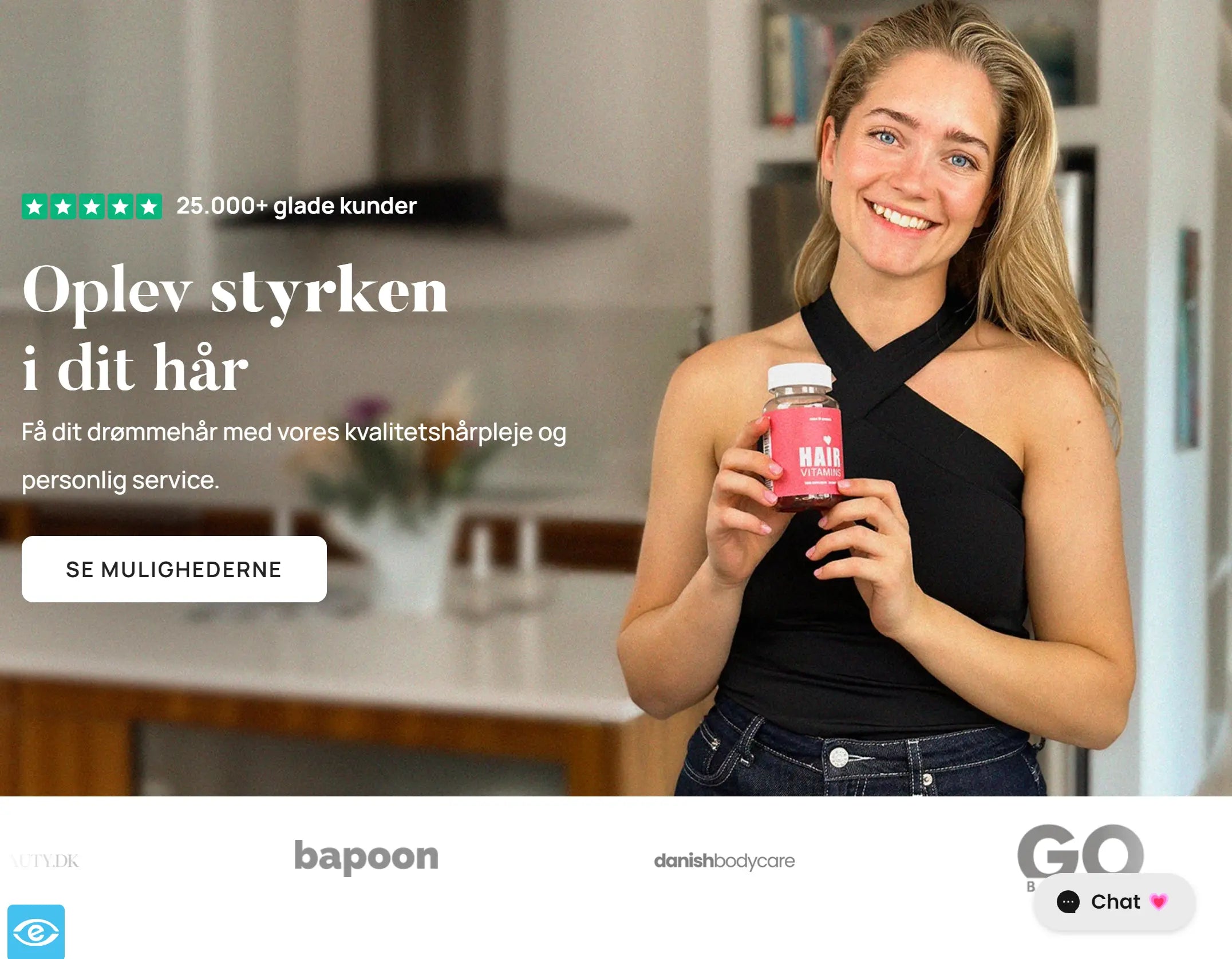

Read through by Dorthe Kristensen
Hairdresser and former co-owner of the award-winning hairdressing chain Zoom by Zoom
With many years of experience in the hairdressing industry, Dorthe has advised many customers about hair and hair care. Dorthe has read through this blog entry to ensure high quality and professionalism. This blog post is professionally updated on May 1, 2025.
Table of contents
Beach waves are known for their casual, sun-kissed texture that gives off an effortless yet stylish impression. As more people seek hair-friendly techniques, heatless and overnight methods have surged in popularity for their ability to create stunning waves without the damage caused by heated styling tools.
This guide focuses exclusively on methods that require no heat—perfect for anyone looking to protect their hair while waking up to beautifully tousled locks.
What are beach waves?
Beach waves are soft, tousled curls that mimic the effortless, wind-swept texture hair often takes on after a day at the beach. This look is defined by its loose, undone style, offering natural movement and volume without appearing overly styled.
Beach waves are suitable for nearly all hair types and lengths, and strike a balance between casual and refined, making them ideal for both everyday wear and more polished occasions. Whether achieved through braiding or salt sprays, the charm of beach waves lies in their versatility and easy-going aesthetic that flatters a wide range of personal styles.
Why go heatless?
Choosing a heatless styling method is a gentle and effective way to maintain your hair’s health over time. Frequent use of heat tools like curling irons and straighteners can lead to dryness, split ends, and breakage. Heatless techniques help prevent this type of damage, allowing your hair to retain its natural shine and strength. It’s also a convenient option—especially when done overnight. By using methods like braids, rollers, or wrapping before bed, you can wake up with styled hair, saving valuable time in your morning routine. Heatless styling works for most hair types and delivers beautiful results without compromising your hair’s health.
How to get beach waves overnight without heat: 4 different methods
Achieving beach waves while you sleep is not only easy but also gentle on your hair. By using one of several proven techniques before bedtime, you can wake up with soft, effortless waves—no heat required. Here are some of the most effective overnight styling methods for creating natural-looking, beachy texture.
Braids
Braids are a classic and gentle way to create wavy hair without heat. The method works especially well overnight and can be adapted depending on whether you want soft beach waves or more defined texture. Follow the steps below for a healthy, natural look.
-
Start with dry or slightly damp hair: Make sure your hair is only lightly damp—never wet—as sleeping with wet hair can cause scalp discomfort and breakage.
-
Apply a curl-enhancing product: Distribute a lightweight curl cream or leave-in conditioner evenly through your hair for moisture and definition.
-
Choose your wave type: Create many small braids for tighter waves or one to two larger braids for a looser, more relaxed look.
-
Section and braid the hair: Divide your hair into sections and braid each one all the way to the ends.
-
Secure with soft elastics: Use snag-free, metal-free bands to avoid breakage.
-
Leave the braids in overnight: Allow the braids to set while you sleep for best results.
-
Gently undo the braids: In the morning, take them out carefully without tugging or brushing.
-
Shape the waves with your fingers: Use your hands to separate and style the waves naturally.
-
Finish with a styling product: Mist lightly with saltwater spray or apply a few drops of hair oil for added volume, hold, and shine.
What’s your favorite heatless method for creating beach waves?
Twists or mini buns
Creating beachy waves using twists or mini buns is a simple, heat-free method that works well for medium to long hair. Follow these steps for soft, voluminous waves by morning:
-
Start with dry or slightly damp hair. Avoid wet hair, as it may not dry fully overnight and can lead to breakage or discomfort while sleeping.
-
Divide your hair into sections. The number of sections will depend on how defined you want the waves. More sections create tighter waves, fewer sections give a looser look.
-
Twist each section. Take one section at a time and twist it tightly away from your face. This direction helps frame the face with outward-facing waves.
-
Form a bun. Coil the twisted strand into a small bun, positioning it at the base or side of your head, wherever feels comfortable.
-
Secure each bun: Use a soft scrunchie or no-crease clip to avoid dents or damage to the hair.
-
Repeat the process: Continue twisting and coiling until all sections of your hair are secured into mini buns.
-
Leave in overnight: Make sure the buns are placed in a way that allows you to sleep comfortably.
-
Undo gently in the morning: Unravel each bun without pulling, and let the waves fall naturally.
-
Separate with fingers: Avoid combs or brushes—use your fingers to break up the waves and create a tousled effect.
-
Set the style: Finish with a spritz of salt spray or a light styling mousse to enhance texture, volume, and hold.
This method offers a low-maintenance, heat-free solution to achieving soft, defined waves with minimal effort.
Headband wrap
The headband method is a simple and gentle way to achieve natural waves without using heat. It’s especially suitable for medium to long hair and can easily be done before bed. The result is soft, relaxed beach waves by morning—with zero damage to your hair. Follow the steps below for a beautiful and lasting result.
-
Start with dry or slightly damp hair: Make sure your hair is completely dry or just barely damp, as wet hair can be uncomfortable and prone to breakage.
-
Position the headband correctly: Use a soft, stretchy headband and place it around your head so it sits comfortably just above the ears.
-
Divide the hair into sections: Split your hair into smaller sections and begin with the front strand near your face.
-
Wrap the hair around the band: Take a section and wrap it over and under the headband repeatedly until it’s fully tucked in.
-
Repeat with the rest of your hair: Continue the process with the remaining sections, working your way around the head.
-
Add hold and definition: Lightly mist your hair with water or apply a curl-enhancing cream if you want more structure.
-
Ensure comfort and security: Make sure everything feels evenly secured and comfortable enough to sleep in.
-
Leave the headband in overnight: Sleep with the headband in place to let the waves set.
-
Release the hair in the morning: Gently remove the headband and use your fingers to separate and shape the waves.
-
Finish with a styling product: Use a light texturizing spray or wave-refreshing mist to set and define the final look.
This method works best for medium to long hair and is one of the easiest and most comfortable ways to create natural, no-heat beach waves.
Foam rollers
Creating natural waves without heat is a gentle and effective approach—especially when using overnight foam rollers. This method is ideal for anyone looking to wake up with soft, defined texture while avoiding the damage caused by hot tools. Follow the steps below for the best results.
-
Starting point: Begin with completely dry or slightly damp hair. Avoid wet hair, as it may not dry fully overnight and can be uncomfortable to sleep on. Slightly damp hair tends to give longer-lasting results.
-
Choosing rollers: Select your roller size based on the type of wave you want. Large rollers create soft, voluminous waves, while smaller rollers result in tighter, more defined texture.
-
Sectioning: Divide your hair into even sections to ensure a consistent wave pattern throughout.
-
Application: Take one section at a time and wrap it around a foam roller, rolling away from your face to achieve a more natural wave direction. Secure the roller at the base with a built-in clip or a gentle fastening.
-
Overnight protection: Cover your hair with a silk scarf or bonnet to reduce frizz and preserve the curl shape while you sleep.
-
Morning removal: Gently remove each roller in the morning, starting from the bottom and working your way up.
-
Styling: Use your fingers or a wide-tooth comb to gently separate the waves and add volume without disrupting the pattern. Avoid brushing, as it can flatten and distort the texture.
-
Finishing: Finish with a light mist of texturizing spray or a flexible-hold hairspray to set the waves and enhance their longevity.
Foam rollers are especially effective for medium to long hair and are ideal for achieving bouncy, defined waves with zero heat damage.
Prepping for overnight styling
Before styling, apply a lightweight leave-in conditioner or curl-enhancing mousse to help shape and hold the wave pattern overnight. Distribute the product evenly throughout the hair, focusing on the mid-lengths and ends where the waves form most prominently. If your hair tends to resist holding a style, consider layering a small amount of styling gel or foam for added hold.
It’s essential that your hair is not soaking wet—just slightly damp—to ensure it dries fully while you sleep. Hair that’s too wet can remain damp until morning, resulting in flat or uneven waves and potential scalp discomfort.
Sleeping on a bamboo pillowcase can reduce friction, minimize frizz, and help preserve your wave pattern. These materials are gentler on the hair than cotton and can make a noticeable difference in the smoothness and longevity of your heatless style.
How to maintain the look
-
Avoid running your fingers through your hair too often during the day, as this can cause your beach waves to fall flat or become frizzy. Instead, gently scrunch your hair with your hands if it needs a quick refresh to maintain the wave shape.
-
Use a light spritz of texturizing spray or a wave-refreshing mist to enhance definition and add body. These products help boost the look of your waves without making them stiff or heavy.
-
If your roots become oily, apply a dry shampoo to absorb excess oil and maintain volume. You can also flip your head upside down and massage the scalp lightly to restore lift and fullness at the roots.
-
In the evening, loosely tie your hair in a braid or a low, soft bun to help preserve the waves while you sleep. Avoid tight hairstyles that can distort the wave pattern or cause unwanted creasing.
-
Sleep on a satin or bamboo pillowcase to minimize friction, which helps prevent frizz and keeps your waves intact overnight.
-
If your waves need a boost the next day, lightly mist them with water or a hydrating leave-in spray. Follow with a small amount of curl-enhancing product or mousse, then gently scrunch to reactivate the texture and definition.
Embrace heatless styling for healthier hair
You don’t need heat to achieve soft, beachy waves. With a bit of overnight prep and the right technique—whether it’s braids, twists, rollers, or a headband wrap—you can wake up to effortless, natural-looking texture. These methods are not only simple and time-saving but also protect your hair from long-term damage. The key is consistency and using gentle products that support your wave pattern. A little care at night and minimal touch-ups in the morning can keep your hair looking fresh, voluminous, and healthy—no heat tools required.
Get a 10% discount code sent to you
Receive the best tips and tricks for your hair from Lotte and Nanna 🥰
 2-5 day delivery
2-5 day delivery
 25.000+ satisfied customers
25.000+ satisfied customers
 Satisfaction Guarantee
Satisfaction Guarantee









